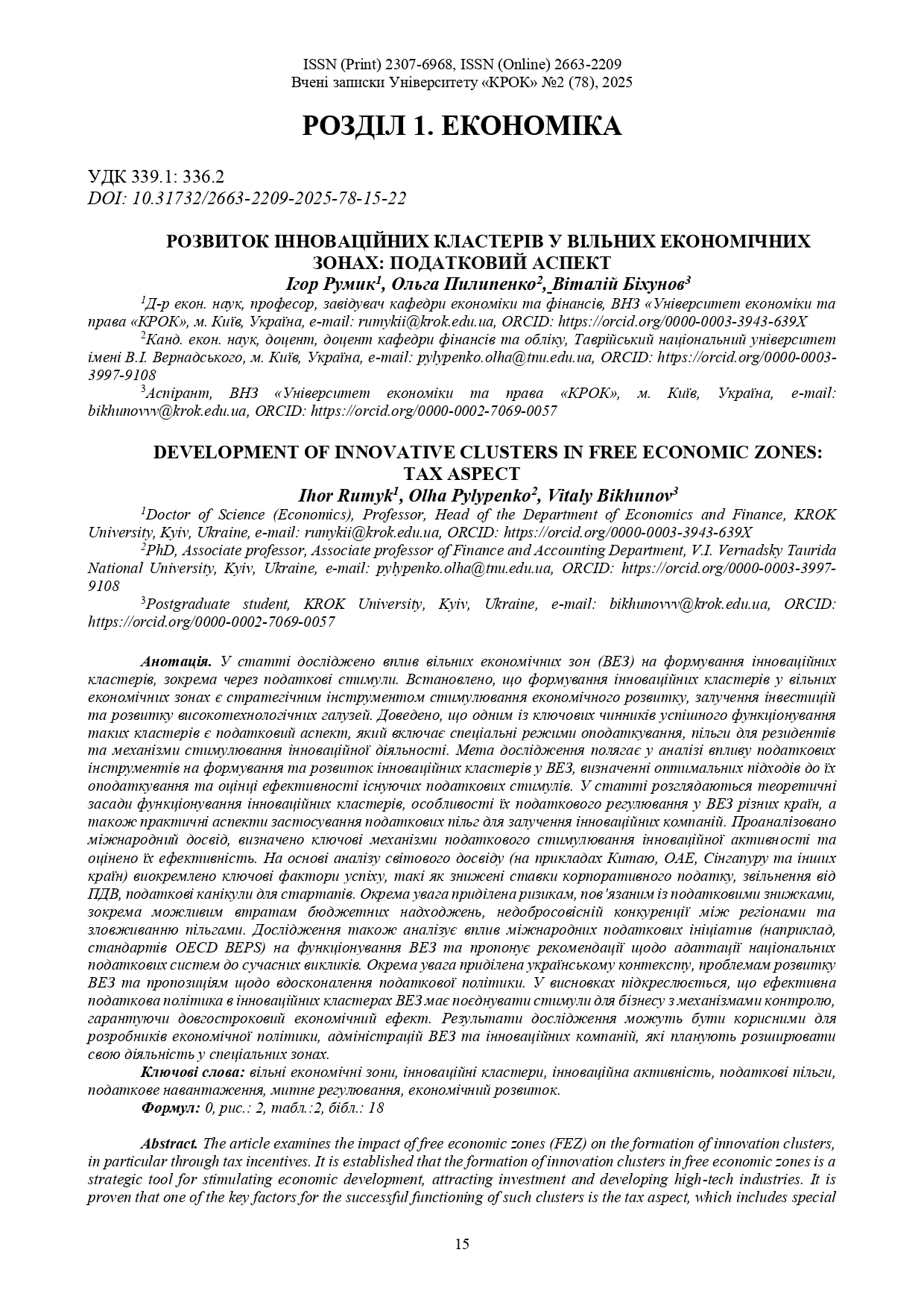DEVELOPMENT OF INNOVATIVE CLUSTERS IN FREE ECONOMIC ZONES: TAX ASPECT
DOI:
https://doi.org/10.31732/2663-2209-2025-78-15-22Keywords:
free economic zones, innovation clusters, innovation activity, tax breaks, tax burden, customs regulation, economic developmentAbstract
The article examines the impact of free economic zones (FEZ) on the formation of innovation clusters, in particular through tax incentives. It is established that the formation of innovation clusters in free economic zones is a strategic tool for stimulating economic development, attracting investment and developing high-tech industries. It is proven that one of the key factors for the successful functioning of such clusters is the tax aspect, which includes special tax regimes, benefits for residents and mechanisms for stimulating innovation activity. The aim of the article is to analyze the impact of tax instruments on the formation and development of innovation clusters in FEZs, determine optimal approaches to their taxation, and assess the effectiveness of existing tax incentives. The article examines the theoretical principles of the functioning of innovation clusters, the features of their tax regulation in FEZs of different countries, as well as practical aspects of the application of tax benefits to attract innovative companies. International experience was analyzed, key mechanisms for tax incentives for innovative activity were identified and their effectiveness was assessed. Based on the analysis of world experience (using the examples of China, the UAE, Singapore and other countries), key success factors were identified, such as reduced corporate tax rates, VAT exemptions, tax holidays for startups. Special attention was paid to the risks associated with tax discounts, in particular, possible losses of budget revenues, unfair competition between regions and abuse of privileges. The study also analyzes the impact of international tax initiatives (e.g., OECD BEPS standards) on the functioning of FEZs and offers recommendations for adapting national tax systems to modern challenges. Special attention is paid to the Ukrainian context, problems of FEZ development, and proposals for improving tax policy. The conclusions emphasize that effective tax policy in SEZ innovation clusters should combine business incentives with control mechanisms, ensuring long-term economic impact. The results of the study may be useful for economic policymakers, SEZ administrations, and innovative companies planning to expand their activities.
Downloads
References
Akinci, G., & Crittle, J. (2008). Special Economic Zones: Performance, Policy, and Potential. World Bank Group. URL: https://documents1.worldbank.org/curated/en/343901468330977533/pdf/458690WP0Box331s0April200801PUBLIC1.pdf
Brauner, Y. (2023). Rethinking tax competition in the digital age. Tax Law Review, 76(2), 45-78. URL: https://www.law.nyu.edu/taxlawreview/issues
Delgado et al. (2016). Defining clusters of related industries. URL: https://www.nber.org/system/files/working_papers/w20375/w20375.pdf
Devereux, M.P., et al. (2021). Taxing profit in a globalized world. Oxford University Press. URL: https://doi.org/10.1093/oso/9780198808060.001.0001
Easson, A. (2021). Tax incentives for foreign direct investment. Edward Elgar Publishing. URL: https://www.researchgate.net/publication/291981478_Tax_incentives_for_foreign_direct_investment_part_I_Recent_trends_and_countertrends
IFC (2023). Annual Report. URL: https://www.ifc.org/en/insights-reports/annual-report-2023
IMF Policy Paper (2023). Tax Incentives in SEZs: Costs and Benefits. URL: https://www.imf.org/en/
Klemm, A., & Van Parys, S. (2012). Empirical evidence on the effects of tax incentives. International Tax and Public Finance, 19(3), 393-423. URL: https://www.imf.org/external/pubs/ft/wp/2009/wp09136.pdf
Мінцифра (2024). Національна доповідь про інновації. Міністерство цифрової трансформації України. URL: https://winwin.gov.ua/assets/files/WINWIN_%D0%9E%D1%81%D0%BD%D0%BE%D0%B2%D0%BD%D0%B0%20%D0%BF%D1%80%D0%B5%D0%B7%D0%B5%D0%BD%D1%82%D0%B0%D1%86%D1%96%D1%8F.pdf
OECD (2021). Tax Incentives for Innovation. URL: https://www.oecd.org/en/topics/r&d-tax-incentives.html
OECD (2022). Economic Outlook. URL: https://www.oecd.org/en/publications/oecd-economic-outlook/volume-2022/issue-2_f6da2159-en.html
Porter, M. (1990). The Competitive Advantage of Nations. Free Press. URL: https://hbr.org/1990/03/the-competitive-advantage-of-nations
Pylypenko, O., Matviienko, H., Putintsev, A., Vlasenko, I. & Onyshchuk, N. (2022). Government tax policy in the digital economy. Cuestiones Políticas, (40(72). DOI: https://doi.org/10.46398/cuestpol.4072.15
Румик, І. (2007). Фінансове забезпечення інноваційної діяльності в українській економіці. Збірник наукових праць «Вчені записки Інституту економіки та права «КРОК», 16, 89-95.
Румик, І., & Пилипенко, О. (2021). Управління фінансово-господарською діяльністю інтегрованих підприємств на інноваційних засадах. Вчені записки Університету «КРОК», (2(62), 166-175. https://doi.org/10.31732/2663-2209-2021-62-166-175
UNCTAD (2023). Annual Report. URL: https://unctad.org/system/files/official-document/osg2024d1_en.pdf
World Bank (2023). Special Economic Zones: Progress and Challenges. URL: https://documents1.worldbank.org/curated/en/752011468203980987/pdf/638440PUB0Exto00Box0361527B0PUBLIC0.pdf
Zeng, D.Z. (2022). How do Special Economic Zones promote innovation? Evidence from China. Journal of Development Economics, 157, 102865. URL: https://www.econbiz.de/Record/-/10013164061

Downloads
Published
How to Cite
Issue
Section
License

This work is licensed under a Creative Commons Attribution-NonCommercial 4.0 International License.

